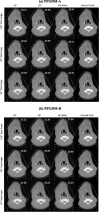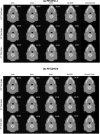Prior frequency guided diffusion model for limited angle (LA)-CBCT reconstruction
- PMID: 38870947
- PMCID: PMC11218670
- DOI: 10.1088/1361-6560/ad580d
Prior frequency guided diffusion model for limited angle (LA)-CBCT reconstruction
Abstract
Objective.Cone-beam computed tomography (CBCT) is widely used in image-guided radiotherapy. Reconstructing CBCTs from limited-angle acquisitions (LA-CBCT) is highly desired for improved imaging efficiency, dose reduction, and better mechanical clearance. LA-CBCT reconstruction, however, suffers from severe under-sampling artifacts, making it a highly ill-posed inverse problem. Diffusion models can generate data/images by reversing a data-noising process through learned data distributions; and can be incorporated as a denoiser/regularizer in LA-CBCT reconstruction. In this study, we developed a diffusion model-based framework, prior frequency-guided diffusion model (PFGDM), for robust and structure-preserving LA-CBCT reconstruction.Approach.PFGDM uses a conditioned diffusion model as a regularizer for LA-CBCT reconstruction, and the condition is based on high-frequency information extracted from patient-specific prior CT scans which provides a strong anatomical prior for LA-CBCT reconstruction. Specifically, we developed two variants of PFGDM (PFGDM-A and PFGDM-B) with different conditioning schemes. PFGDM-A applies the high-frequency CT information condition until a pre-optimized iteration step, and drops it afterwards to enable both similar and differing CT/CBCT anatomies to be reconstructed. PFGDM-B, on the other hand, continuously applies the prior CT information condition in every reconstruction step, while with a decaying mechanism, to gradually phase out the reconstruction guidance from the prior CT scans. The two variants of PFGDM were tested and compared with current available LA-CBCT reconstruction solutions, via metrics including peak signal-to-noise ratio (PSNR) and structural similarity index measure (SSIM).Main results.PFGDM outperformed all traditional and diffusion model-based methods. The mean(s.d.) PSNR/SSIM were 27.97(3.10)/0.949(0.027), 26.63(2.79)/0.937(0.029), and 23.81(2.25)/0.896(0.036) for PFGDM-A, and 28.20(1.28)/0.954(0.011), 26.68(1.04)/0.941(0.014), and 23.72(1.19)/0.894(0.034) for PFGDM-B, based on 120°, 90°, and 30° orthogonal-view scan angles respectively. In contrast, the PSNR/SSIM was 19.61(2.47)/0.807(0.048) for 30° for DiffusionMBIR, a diffusion-based method without prior CT conditioning.Significance. PFGDM reconstructs high-quality LA-CBCTs under very-limited gantry angles, allowing faster and more flexible CBCT scans with dose reductions.
Keywords: cone-beam CT; diffusion model; image reconstruction; limited angle.
Creative Commons Attribution license.
Conflict of interest statement
The authors have no relevant conflicts of interest to disclose.
Figures












Update of
-
Prior Frequency Guided Diffusion Model for Limited Angle (LA)-CBCT Reconstruction.ArXiv [Preprint]. 2024 Apr 9:arXiv:2404.01448v2. ArXiv. 2024. Update in: Phys Med Biol. 2024 Jun 26;69(13). doi: 10.1088/1361-6560/ad580d. PMID: 38659638 Free PMC article. Updated. Preprint.
Similar articles
-
Prior Frequency Guided Diffusion Model for Limited Angle (LA)-CBCT Reconstruction.ArXiv [Preprint]. 2024 Apr 9:arXiv:2404.01448v2. ArXiv. 2024. Update in: Phys Med Biol. 2024 Jun 26;69(13). doi: 10.1088/1361-6560/ad580d. PMID: 38659638 Free PMC article. Updated. Preprint.
-
MBST-Driven 4D-CBCT reconstruction: Leveraging swin transformer and masking for robust performance.Comput Methods Programs Biomed. 2025 Apr;262:108637. doi: 10.1016/j.cmpb.2025.108637. Epub 2025 Feb 6. Comput Methods Programs Biomed. 2025. PMID: 39938253
-
Using a patient-specific diffusion model to generate CBCT-based synthetic CTs for CBCT-guided adaptive radiotherapy.Med Phys. 2025 Jan;52(1):471-480. doi: 10.1002/mp.17463. Epub 2024 Oct 14. Med Phys. 2025. PMID: 39401286
-
Dynamic cone-beam CT reconstruction using spatial and temporal implicit neural representation learning (STINR).Phys Med Biol. 2023 Feb 6;68(4):045005. doi: 10.1088/1361-6560/acb30d. Phys Med Biol. 2023. PMID: 36638543 Free PMC article.
-
Mitigation of motion-induced artifacts in cone beam computed tomography using deep convolutional neural networks.Med Phys. 2023 Oct;50(10):6228-6242. doi: 10.1002/mp.16405. Epub 2023 Apr 11. Med Phys. 2023. PMID: 36995003
Cited by
-
Unsupervised Bayesian generation of synthetic CT from CBCT using patient-specific score-based prior.Med Phys. 2025 Apr;52(4):2238-2246. doi: 10.1002/mp.17572. Epub 2024 Dec 12. Med Phys. 2025. PMID: 39666566 Free PMC article.
References
-
- Amirian M, Barco D, Herzig I, Schilling F P. Artifact reduction in 3D and 4D cone-beam computed tomography images with deep learning: a review. IEEE Access. 2024;12:10281–95. doi: 10.1109/ACCESS.2024.3353195. - DOI
-
- Anderson B D O. Reverse-time diffusion equation models. Stoch. Process. Appl. 1982;12:313–26. doi: 10.1016/0304-4149(82)90051-5. - DOI
-
- Bayaraa T, Hyun C M, Jang T J, Lee S M, Seo J K. A two-stage approach for beam hardening artifact reduction in low-dose dental CBCT. IEEE Access. 2020;8:225981–94. doi: 10.1109/ACCESS.2020.3044981. - DOI
MeSH terms
Grants and funding
LinkOut - more resources
Full Text Sources
